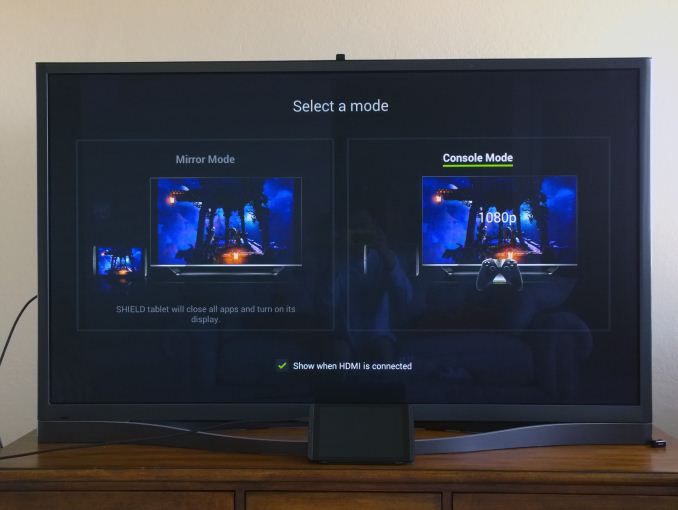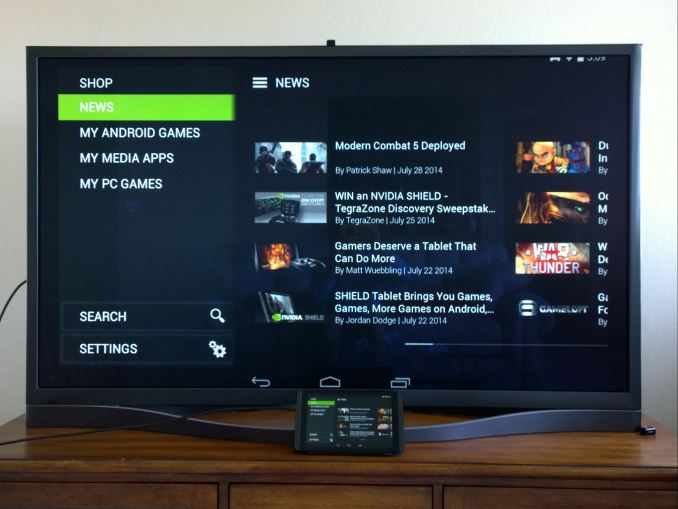The NVIDIA SHIELD Tablet Review
by Joshua Ho on July 29, 2014 9:00 AM ESTSoftware
In the UI department, there’s not too much to talk about. Much like Motorola, NVIDIA has stuck to using the AOSP UI design. Of course, there are plenty of NVIDIA-specific applications, but I didn’t run into any issues using the tablet to do everyday tasks. In this respect, things have improved massively over Shield portable. Because this tablet works in both portrait and landscape, there aren’t any issues with applications that force portrait mode like there were with the Shield portable. In normal tablet usage, it works as one might expect, with no real perceived lag throughout the UI. Of course, this is when compared to other Android devices. There are still frame drops involved in scrolling through lists and similar areas where Android has traditionally struggled to stay smooth, but Android L should fix this issue for the most part.
DirectStylus 2
The real value that the Shield tablet brings as a tablet is the stylus functionality. DirectStylus 2 is definitely much, much better than any other capacitive stylus on the market. The tip allows for precise control and it’s definitely responsive to changes in pressure. For the most part, there are only small issues here. Because the stylus is capacitive, it’s not really possible to have a floating pointer the way Wacom styluses do. In addition, I noticed that I need to lift the stylus a bit more than I might with pencil and paper in order to start a new letter or word or else my words would start to flow together. For the most part though, it works well enough, and the inking latency is low. Unfortunately the issue here is more of ecosystem than hardware, as most stylus-enabled applications aren’t nearly as robust as OneNote on Windows x86.
Console Mode
Of course, the real question here is whether the gaming side is worth the price premium. NVIDIA has gone all out on this area, and their efforts are split up into multiple aspects. The first is the TV interface/console mode, then the gameplay recording feature known as ShadowPlay. Finally, there’s the aspect of GameStream and GRID, which make it possible for games to be played on the tablet that otherwise wouldn’t work due to the compute requirements.
The TV interface effectively boils down to Shield Hub and Google Now, although it’s fully possible to use the full tablet UI as desired in this mode. In the hub, launching games and various applications like YouTube and Netflix is rather simple compared to the more cumbersome full Android UI as they have their own category in Shield Hub. In addition, launching applications through Google Now works as expected. Overall, there aren’t any friction points here. It works as well as one could expect. There is a strong reliance on voice input in general, but it’s much better than trying to type with a controller and better than most smart TV experiences. While the TV interface is mostly targeted towards enabling a console gaming experience, YouTube and Netflix both work great in this mode. NVIDIA has also gone through the necessary DRM certification process to allow for 1080p Netflix streaming. In essence, this device is already ready to serve as an Android TV device.
ShadowPlay
ShadowPlay, which we first saw in GeForce GTX GPUs, is also another major advantage that NVIDIA brings to the table for software experience. In short, this leverages the hardware H.264 video encoder that is on the Tegra K1’s Kepler GPU to provide video capture of gameplay or anything else displayed by the tablet. There are three possible options for video capture. The first is Twitch broadcasting, something that NVIDIA is quite proud of as they are the first to implement such a feature in an Android tablet. While I personally don’t stream on Twitch, a demo of Twitch broadcasting in the initial launch briefing worked without any visible quality issues in either audio or video.
There are two other recording modes. One is a standard start/stop recording feature, but the other is ShadowPlay/Auto Recording. In short, this keeps anywhere from the past minute to 20 minutes in video. This makes it possible to set and forget about the recording feature rather than constantly managing recordings in manual mode. All of these modes can use the tablet’s microphone and front facing camera for commentary purposes as needed. Local recordings seem to have a maximum of 1080p30, and Twitch broadcasts are limited to 720p30.
While those are the technical details, it’s a painless process. All the user has to do is long press the back button on the controller and select what kind of a recording they’d like to do (Twitch, Auto, Manual, Screenshot) and that’s it. I can see significant potential in this area especially if this device takes off as a gaming platform.
















174 Comments
View All Comments
ams23 - Tuesday, July 29, 2014 - link
Oh and by the way, Shield tablet has a native resolution of 1920x1200. The 1080p offscreen tests in GFXBench are done at a resolution of 1920x1080. They are not the same thing! Shield tablet native resolution is higher than the 1080p offscreen resolution, and that is why fps is always a bit lower onscreen vs. offscreen.lucam - Wednesday, July 30, 2014 - link
I almost agree with you. Nevertheless it's worth saying this is the first Nvidia SOC with so fast GPU. Having this sort of performance might have a drastic trade off on power consumption. I think if the A8 will have similar performance of K1 and better energy saving then yes. I doubt, by the way, the A8 will have better performance. In this round Nvidia has made better GPU performance. Question would be...isn't enough to sell enough tablets?UpSpin - Friday, August 1, 2014 - link
Nice how you throw around you with meaningless numbers. Let's get your nonsense right:Performance:
I use this benchmark comparison as base:
http://gfxbench.com/compare.jsp?benchmark=gfx30&am...
The iPad Air has a 30WHr battery, got released on November 1, 2013 and costs $500.
The NVidia Shield tablet a 20WHr battery, got released now and costs $300.
The iPad Air has in the GFX battery rundown a power consumption of 5.4WHr.
The NVidia Shield tablet hasin the GFX battery rundown a power consumption of 9.38WHr.
The iPad Air vs. the NVidia Shiled tablet has an average frame rate of
Manhatten: 12.7 FPS vs 31 FPS -> 2.44x
T-Rex: 26.2 FPS vs 65 FPS -> 2.48x
Long Term: 21.3 FPS vs 56.3 FPS -> 2.65x
Now let's put all the things together, considering the higher performance of the Tegra K1, together with the higher power consumption but also higher battery capacity of the iPad Air and we get:
The Shield Tablet consumes 1.73 times the power of the iPad Air, but performs 2.65 times faster.
If Apple clocks the A7 higher, so it consumes the same power the Tegra K1 does, the Tegra would be 1.53 times faster. Now add the fact that the Tegra K1 supports Full Open GL 4.4 and one should see, the GPU of Tegra K1 is a monstrosity. Not so the outdated A15 CPU, but for this they will release the 64bit version soon, which will fix this limiting factor.
Efficiency:
Web browsing: 10hr vs. 10.8hr -> iPad: 3Whr vs. Nvidia: 1.85Whr
Conclusion:
The Tegra K1 is faster and more efficient.
Guspaz - Tuesday, July 29, 2014 - link
The GPU is definitely fast, but how power efficient is it? If they've made a GPU that produces 2x the performance at 3x the power draw, then that's not going to be terribly competitive.Are there any tests that could validate this? Something like a GPU benchmark performed at a fixed framerate with the screen off?
ams23 - Tuesday, July 29, 2014 - link
One would have to measure at the voltage rails (which is what NVIDIA did when comparing TK1 to S800 and A7).grahaman27 - Tuesday, July 29, 2014 - link
Its definitely more efficient. Nvidia claims its 1.4x as efficient.melgross - Tuesday, July 29, 2014 - link
Over the years, Nvidia has made a lot of claims that have turned out to not be true. I'd like to see the measurements.FriendlyUser - Tuesday, July 29, 2014 - link
The technology is cool and it really looks like a premium product, something relatively rare in the android space. However, I'm still looking for a use case. I mean, why would I stream from a PC instead of playing on the PC, if it is in the vicinity? And why would anyone pay serious money for gaming on the go instead of just using a smartphone for the few moments were mobile gaming might be interesting. And, if someone really needs to game on the go, 2.5h seems too few...Anyway, the technology is really nice and the execution is quite good. If I were in the market for a tablet I would think about it. Not tempted to upgrade, though.
SpartyOn - Tuesday, July 29, 2014 - link
I have a 1st gen Shield and it's for people like me: someone who sits at a desk all day and when he comes home doesn't want to sit at another desk or use a mouse anymore. I used to hook my mITX PC up to the HDTV and play with a controller, but then when I wanted to play an RTS or an MMO, I would move it back to my study. That's just cumbersome and requires a ton of wires in both locations.With the Shield, I can carry it around easily as a handheld and hook it up to my TV in Console Mode to get 1080p game streaming - all while now leaving my PC in the study for good. A couple other great use cases: playing PC games in bed while still being able to chill with my wife, outside enjoying fresh air, sitting on the toilet, and I've even sat on a lounger in the middle of my pool and streamed games.
If playing PC games in the middle of a pool surrounded by sunshine doesn't sound boss, then I don't know what is.
FriendlyUser - Tuesday, July 29, 2014 - link
Yeah, admittedly playing in a pool does sound cool. You do have a point there. My major obstacle would be paying for the pool, I guess...